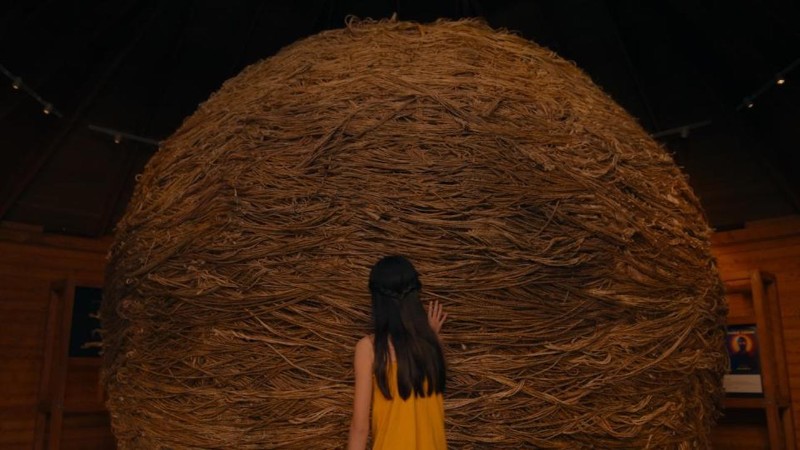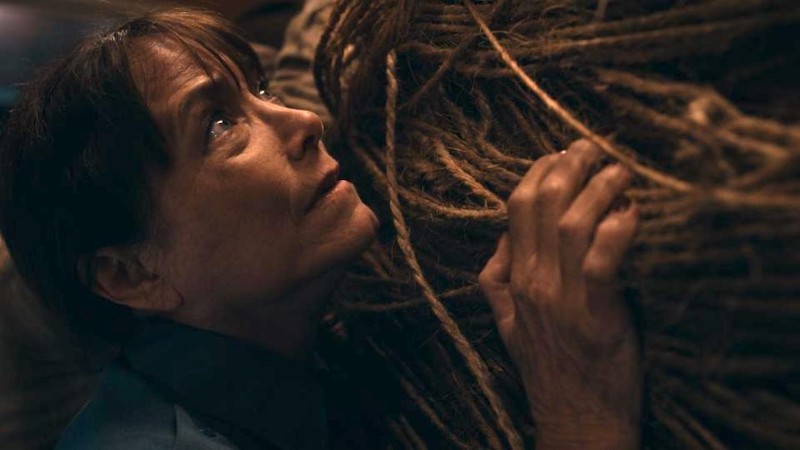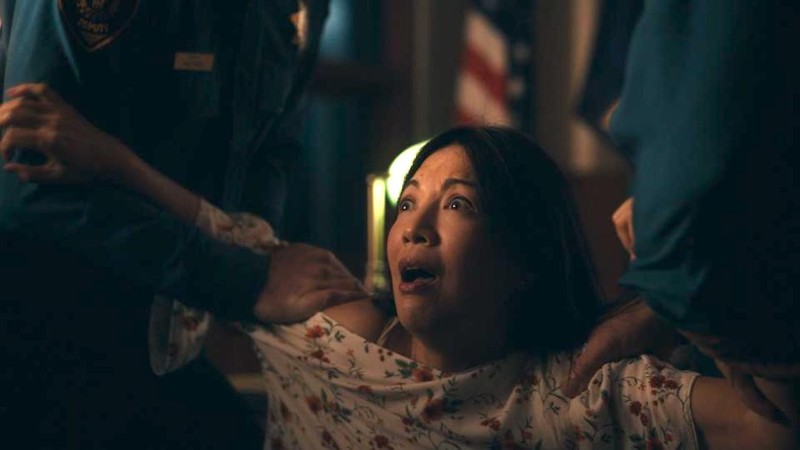The word “twine” conjures up Julie Andrews singing the joyful Sound of Music song “My Favorite Things.” Especially the verse: “Brown paper packages tied up with strings.” It’s sweet, cheerful, and even a bit romantic.
In other words, string and, in this case, twine are hardly the things of nightmares. So the title for the second episode of the Sam Raimi produced horror-anthology 50 States of Fright: “Ball of Twine” doesn’t exactly run shivers down our spine.
Until we press play and step into the doomed shoes of a mother and daughter driving through a small town in Kansas . . . and their grave mistake in stopping to view its roadside attraction.

“Ball of Twine”
★★★★ out of ★★★★★
“Ball of Twine” uses the same camera confessional flashback format juxtaposed with the real-time terror as “The Golden Arm”. This time, a small-town sheriff is the narrator, and the disappearance of a mother and her daughter is on the table.
Ten seconds into the episode, we already get a sense of the characters’ personalities and their motivations. Susan (Ming-Na Wen, Mulan, and Agents of S.H.I.E.L.D.) and her tween daughter Amelia (Thailey Roberge, Home Before Dark) are both grieving the loss of a loved one and on top of that are moving to a new city.
There’s a distance between the disenchanted and (justifiably) surly Amelia, and Susan is determined to bridge that gap by embarking on an impromptu road trip. She wants to reinforce the bond between them and to become closer. Little does she know that her request will be met in the kind of darkly cheeky way that would make Edward Gorey, Robert D. San Souci, and Alvin Schwartz chuckle.

I didn’t want to write off 50 States of Fright just because the first episode flopped. I’m glad I kept to that mindset, because “Ball of Twine” is everything “The Golden Arm” wasn’t.
The instant Susan and Amelia set foot in Frances, Kansas, and are hammered with questions by an oddly guarded townie, it’s apparent that all is not right in this small town in Kansas. The sudden arrival of Frances’ overly chipper Sheriff Stallings (Karen Allen, Year By the Sea and Raiders of the Lost Arc) just adds to the tentative unease . . . as does her best take on Little Red Riding Hood’s wolf’s the-better-to-eat-you-with grin as she remarks, “Children have an affinity for the ball”.
Frances, Kansas certainly isn’t the Kansas of scrappy terrier Toto and plucky Oz-trotting heroine Dorothy. Instead, this is more the type of secretly unsavory town the Winchester brothers in the early seasons of Supernatural would mosey on into to face off against their monster of the week.
This monster, though, is as unlikely as they come: an ominous 20,000-pound ball of twine, housed in its own wooden pavilion as if it were some Greek God of old proudly displayed in its temple.
While you or I would NOPE right out of there, Amelia has no such qualms and makes a beeline for the bizarre ball. Then, promptly, goes missing.

If effective, engrossing, and cheeky, but unapologetically grim, horror is what you seek, this episode NAILS it.
“Ball of Twine” accomplishes everything “The Golden Arm” failed to do. The world-building wraps tightly around us, and the characters are fueled by motivations that we can not only see but can practically feel through the screen.
“Ball of Twine” intrigues us, creeps us out, and taps into a near primal fear in all of us. Perhaps most importantly, this episode has stakes!
The beauty, or rather, sheer potency and grotesqueness, of “Ball of Twine” lies in its simplicity and surge of relatable human emotion. “Ball of Twine” takes human nature—the very frightening idea of suddenly losing a loved one—and lifts it up to a supernatural level.
Susan isn’t merely a worried mother, determined to do anything to find her daughter. She’s a mirror to reflect back ourselves.
Her grief and desperation, married with the frantic impending doom of time running out to save Amelia, are human emotions that were so sorely missing in “The Golden Arm.” Even better, these human emotions are here in spades. We’re invested in these characters. The anxiety we feel about their wellbeing and the urgency we feel for them to GET. AWAY. rushes over us like a roaring wave.
Even if we don’t necessarily have children, we all have someone we’d do anything for. Who we’d risk everything for. Even our lives. That panic, desperation, and just how real having someone up and vanish one day is, inextricably entwines us into Susan’s story.
Rife with relatable characters, universal human emotion, high stakes, and some seriously badass special effects, “Ball of Twine” doesn’t need flimsy tropes, gore, or uninspired jump scares to keep us fixed to the screen. And we won’t soon forget its quiet dread and penultimate final scene . . .


Comments are closed.